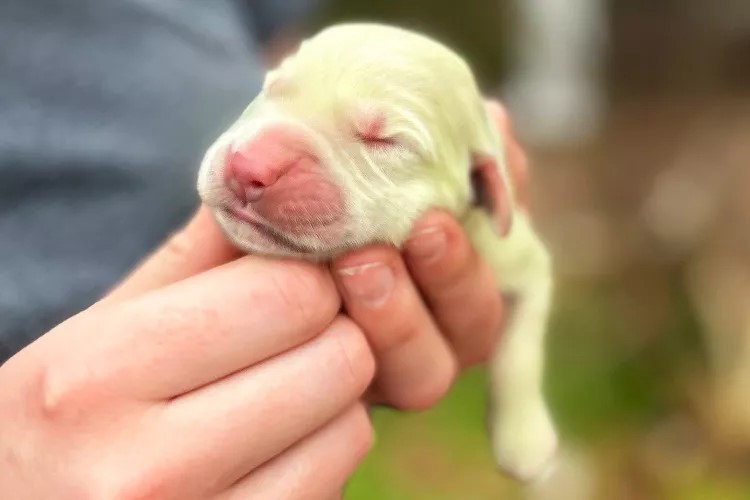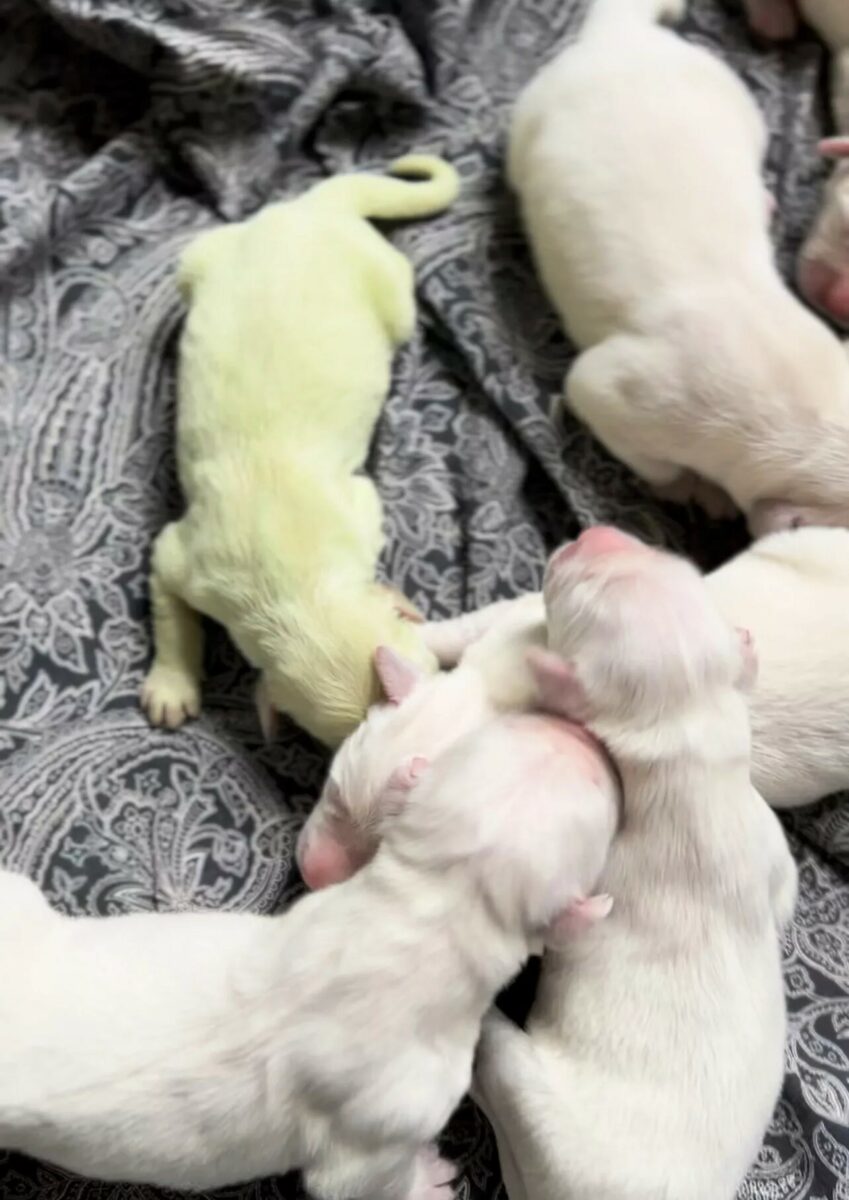Life is a miracle in itself, and it is a special kind of happiness when a litter of cute puppies comes into the world. That’s how it was when one Golden Retriever mom gave birth to a wonderful little dog in Pensacola, Florida.
However, this litter was not like the others, and the main reason was one unique Goldie. Unlike the other puppies whose coats were blonde, which is the main characteristic of this breed, hers was a different colour.
Although the breeders were shocked at first, they soon realized that this uniqueness worked in her favour.
Rare But Beautiful Occurance

This litter of eight puppies came into the world on March 3, 2024. At first, there was nothing special about the little ones except, of course, their limitless cuteness. However, when they looked a little closer, the breeders saw that one puppy was different.
Carole DeBruler and her husband, Greg, breeders from Golden Treasures Kennel, located in Pensacola, Florida, were more than surprised when they saw that one puppy had a dark green hue.

“We were kind of shocked,” Carole told PEOPLE. In their 17 years of working on raising light-coloured puppies, they have seen “some green or a slight tint” many times, but never the coat that was entirely dark green.
Also, because any green usually “rubs right off”, they tried that in this case as well. Unfortunately, it was all in vain.
“Mom cleans them, we clean them, and it comes off — hers didn’t,” Carole said. “This is rare.”

However, after a few baths from Carole, as well as a lot of “kisses” from her mom, the puppy’s coat went from dark green to bright lime green. Shamrock, as they named the baby dog, was now not only special but more beautiful than any “ordinary” puppy.
“And she stayed lime for a good while,” Carole confirmed.
“A Lucky Dog”
Because she was such a special pup, Carole and her husband decided to record a video about Shamrock and post it on their TikTok account, @living_the_golden_life.
They couldn’t have dreamed how much attention it would attract. This video showed a Golden Retriever mom nursing her puppies, including the special one. In addition, they explained how Shamrock’s coat took on such a specific colour.
“She is a rare pup whose white fur was stained in the womb with biliverdin,” it was stated in the video. According to Breeding Business, biliverdin is a pigment found in the bile of dogs and it is responsible for the green colour of bile, sometimes affecting the puppy’s coat colour.
Carole and her family didn’t stop at that one video but continued to promote Shamrock, causing interest in her to skyrocket.
“I’m just so excited to share Shamrock with the world,” Carole said. “She was a lucky dog!”
With time, Shamrock grew up, and the green colour from her fur slowly faded, leaving a beautiful golden coat – a trademark of every Golden Retriever.
A Top Pick

The popularity that the green colour brought her and the current beauty and cuteness with which she shone helped Shamrock to be the top pick for her new family. In other words, among all the puppies from the litter, she was the first to find a forever home.
“The gentleman getting her has just retired, and she will be his world. He loves her already so much,” Carole said. “She’s so loved now, and she’s going to be so loved in the future —and that makes me happy.”
We hope her new family will treat her like a special dog because that’s exactly what she was from the day she was born.
Ever wondered why your furry companion ages so differently from you? Understanding how dog years work can shed light on this fascinating aspect of canine life. As a seasoned dog trainer, you’ve witnessed firsthand the unique way in which dogs age compared to humans. It’s a captivating journey that reveals the intricacies of our loyal companions’ lifespan.
Diving into the concept of dog years opens up a world of discovery about the aging process in our four-legged friends. With your expertise in training dogs of all ages, you’ve grasped the nuances of their development over time. Dog years are more than just a numerical calculation; they’re a window into the remarkable bond we share with our beloved pets.
Understanding Dog Years
If you’ve ever wondered how dog years work, it’s all about understanding the aging process of our canine friends. Dogs age at a different rate than humans, and the concept of dog years helps us gauge their life stages better.
1. The Ratio Conversion
Dog years are often compared to human years using a ratio. The commonly accepted ratio is that one dog year is equivalent to seven human years. However, this is a general estimate and doesn’t apply uniformly to all dogs. Different dog breeds age at different rates.
2. Ageing Factors
Several factors influence how dogs age, including breed, size, genetics, and overall health. Larger breeds tend to have shorter lifespans than smaller ones. Genetics also play a significant role in determining a dog’s aging process.
3. Life Stages
Understanding dog years helps us categorize a dog’s life into stages that align more closely with their development. Puppyhood, adolescence, adulthood, and senior years are the main life stages of a dog, each requiring specific care and attention.
4. Health Care
As dogs age, their health needs change. Regular vet check-ups, proper nutrition, exercise, and mental stimulation are crucial for ensuring a dog’s well-being at every stage of their life.
By grasping the concept of dog years, you can better appreciate the different phases of your canine companion’s life and provide them with the care and love they deserve.
Factors Influencing Dog Aging
Here are key factors that influence how dogs age and what you should consider for your furry friend:
1. Breed
Different dog breeds have varying lifespans and aging processes. Larger breeds tend to have shorter lifespans than smaller ones. For example, Great Danes are considered seniors at around 6-7 years old, while Chihuahuas may not reach this stage until 10-12 years.
2. Genetics
Genetics play a crucial role in how dogs age. Some breeds are more prone to certain health issues that can impact their longevity. Understanding your dog’s genetic predispositions can help you anticipate and address potential age-related issues.
3. Health Care
Proper healthcare is essential for managing your dog’s aging process. Regular vet check-ups, vaccinations, parasite control, and dental care can all contribute to your dog’s overall health and well-being as they age.
4. Nutrition
Nutrition requirements change as dogs age. Senior dogs may need specially formulated food to meet their changing nutritional needs. It’s crucial to provide a balanced diet to support your dog’s health throughout their life stages.
5. Exercise
Regular exercise is vital for keeping your dog healthy and agile as they age. Tailoring the intensity and duration of exercise to your dog’s age, breed, and health status can help prevent obesity and maintain muscle strength.
6. Mental Stimulation
Just like humans, dogs benefit from mental stimulation to stay sharp and engaged. Interactive toys, training exercises, and puzzle games can help keep your dog’s mind active and prevent cognitive decline as they age.
Understanding these factors that influence dog aging can help you provide the best care for your canine companion at every stage of their life.
Calculating Dog’s Age in Human Years
If you’ve ever wondered how old your furry companion is compared to yourself, understanding how to calculate your dog’s age in human years can provide valuable insights into their life stage. Here’s a straightforward method to estimate your dog’s age conversion:
Dog Years to Human Years Ratio:
- For the first two years of a dog’s life, each human year is roughly equivalent to ten and a half dog years.
- After the initial two years, each human year typically equals about four dog years.
- Breed: Different breeds age at varying rates, with small dogs generally living longer than larger breeds.
- Genetics: Genetic factors play a significant role in a dog’s lifespan and aging process.
- Healthcare: Proper veterinary care can prolong a dog’s life and improve their quality of life.
- Nutrition: A balanced diet tailored to your dog’s needs contributes to their overall health and longevity.
- Exercise: Regular physical activity is essential to maintain your dog’s health and prevent obesity.
- Mental Stimulation: Keeping your dog mentally engaged helps slow cognitive decline as they age.
Understanding how to calculate your dog’s age in human years can guide you in providing the best care at every stage of your beloved companion’s life.
Health Implications of Aging in Dogs
As your furry companion ages, their health needs change, requiring extra attention from you. Here’s what to keep in mind:
1. Regular Veterinarian Visits
Just like humans, older dogs are more prone to health issues. It’s essential to schedule regular check-ups to monitor their health and catch any problems early.
2. Proper Nutrition
A well-balanced diet is crucial for aging dogs. Adjust their food intake based on their activity level, breed, and any health conditions they may have.
3. Exercise
Even as they age, dogs need physical activity to stay healthy and maintain a healthy weight. Tailor their exercise routine to their age and physical abilities.
4. Mental Stimulation
Keep your dog’s mind sharp with interactive toys, training sessions, and new experiences. Mental stimulation is as important as physical exercise for their overall well-being.
5. Specialized Care
As your dog gets older, they may require specialized care tailored to their individual needs. Be attentive to any changes in behavior or health and adjust their care accordingly.
Remember, providing proper care and attention to your aging dog can help ensure they live a comfortable and happy life in their golden years.
Conclusion
That wraps up the lowdown on how dog years work. Remember, understanding your furry friend’s age in human terms involves more than just simple math. Factors like breed, genetics, and overall care play a crucial role in their aging process. Keep in mind the importance of regular vet check-ups, a balanced diet, exercise, and mental stimulation to ensure your canine companion’s well-being throughout their life stages. By providing the right care and attention, you can make sure your aging pup enjoys their golden years to the fullest.
Frequently Asked Questions
What are dog years, and how do dogs age differently from humans?
Dogs age faster than humans due to their shorter lifespan. The myth of “one dog year equals seven human years” is oversimplified. Small breeds generally live longer than large breeds. Factors like genetics, breed, healthcare, nutrition, exercise, and mental stimulation all influence a dog’s aging process.
How can I calculate my dog’s age in human years?
A common method to estimate a dog’s age in human years is to multiply the first two years of a dog’s life by 10. After that, add 4 human years for each dog year.
What are the key factors to consider for optimal care of aging dogs?
Proper healthcare, tailored nutrition, regular exercise, mental stimulation, and veterinarian visits are critical for aging dogs. Understanding their breed-specific needs and providing specialized care can help maintain their quality of life in their golden years.
[no_toc]

Hey there, I’m Janet Brooks, a dog-loving student from California. I’m all about helping pups in need, especially those without homes. Me and my awesome friends work together to give shelter and love to stray dogs. Oh, and I also write blogs about dogs to share helpful info.